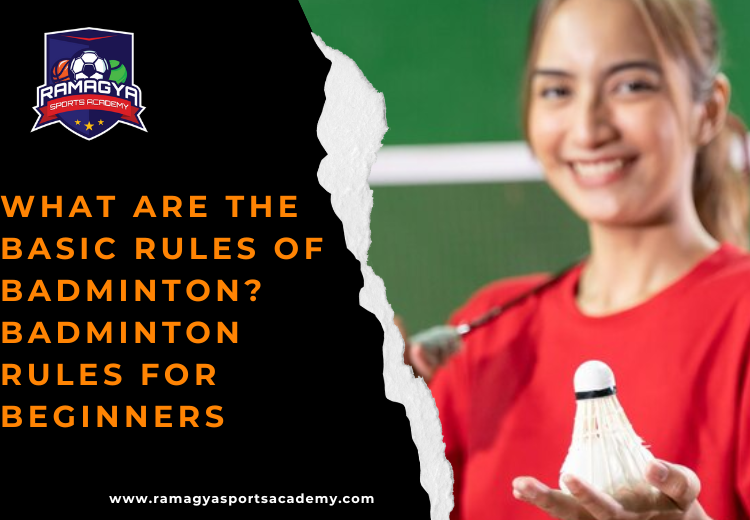
Congrats to Shivansh Nandurkar for winning Bronze at District Level Karate Championship
November 6, 2024
Pragyan Bhati Shines at the AITA U16 & U18 National Ranking Tennis Championship 2024
November 11, 2024What Are the Basic Rules of Badminton? Badminton Rules for Beginners

Badminton is a fun and energetic sport that can be enjoyed by people of all ages. Whether you’re playing casually with friends or looking to improve your skills through badminton training, understanding the basic badminton rules is essential.
In this blog, we’ll cover the fundamental badminton rules for beginners and help you get started on the right foot.
1. Court and Equipment
Before you dive into the badminton rules, it’s crucial to be aware of the court as well as the equipment required to play. Badminton is played in singles (one player per team) and doubles (two teams of two players each). Here’s the information you should be aware of:
- Court: The court for badminton training is rectangular and divided by an edging at the center. Singles’ courts are 13.4 meters in length as well as 5.18 meters in width. Doubles have a court’s width raised by 6.1 meters. 6.1 meters.
- Net: The net is placed at an altitude of 1.55 meters near the edge along the edges and 1.524 meters at the middle.
- Racket: A light badminton racket is used to smash the shuttlecock.
- Shuttlecock: A shuttlecock is the object that is thrown back and forward. It’s typically composed of feathers or plastic.
2. Serving Rules
A major and essential aspect of a good training program for badminton is learning how to serve. When playing badminton the game begins with a serve. There are rules specific to badminton concerning how this is done.
- Serve below the Waist: The server must strike the shuttlecock at a height below waist and the racket needs to make contact downwards after making contact.
- Diagonal Serve: The serve must be through the court diagonally before reaching your opponent’s service box.
- Foot position: Both the receiver and server should keep their feet down until their shuttlecock has been hit.
- Singles and Doubles Serving Rules: For singles, the serving area has to fit within the narrow and lengthy service area. In doubles, it has to fit within the wider, but smaller service area.
3. Scoring System
Learning what it takes to earn points is essential to understanding the game. The rules for scoring are easy and simple.
- Rally Scoring: Modern badminton training uses the rally scoring system and points are given to the winner of any rally in spite of the person who played.
- Winning a Game: The game is played with 21 points. In order to win a game players or teams must hold at least an advantage of two points. If the score is 20-20, the game continues until one team is ahead by two points or more, to the maximum of 30 points.
- Match Format: A match typically consists of 3 games. The first team or player to win two games takes the match.
4. Faults in Badminton
It is vital to avoid making mistakes when it comes to training for Badminton because committing a mistake could cause a point for the opponent. Here are some of the most common mistakes to be aware of:
- Serving Fault: If the shuttlecock gets hit over the waist or the serve isn’t placed in the right service zone there is a problem.
- Out of Bounds: If the shuttlecock is thrown outside of the boundary lines it’s considered to be out of bounds. The opposing team or player receives the point.
- Net Contact: Players are not permitted to touch the net using their body or racket during an event.
- Double Hit: Shuttlecocks can only be struck once per side in the course of a rally. Doing it more than once is considered to be a blunder.
5. In and Out
One of the fundamental rules to be aware of is to know what’s “in” and “out.” The lines that indicate the boundaries of the court are an integral part of the playing space. If the shuttlecock falls on any of these lines the court is considered to be in. During rallies, players have to ensure that the shuttlecock stays within these limits to keep from losing points.
- Singles Boundaries: When playing singles, boundary lines are a bit narrower. The border line in the back is utilized to serve rallies and serves.
- Doubles Boundaries: When playing doubles, sides are longer, while the boundary to back is smaller to allow serving. When the rally starts the border line in the back is utilized.
6. Let
A “let” is a situation where the rally is stopped and replayed without any change in the score. According to badminton rules, a let is called under specific circumstances:
- Interference: If there’s an external disturbance during the event for example, a person entering the court.
- Shuttlecock Catches on the Net: If the shuttlecock becomes stuck in the net or within the web during service and stays there.
7. Basic Strategy and Tips
In addition to knowing the rules of Badminton, acquiring basic strategies can enhance your game. No matter if you’re playing just for fun or trying to improve your skills at it, these strategies can be helpful:
- Footwork: Good footwork is essential in badminton. Make sure you are moving swiftly and effectively across the court until you are able to reach the shuttlecock.
- Shot Variety: Mix up your shots by using drops, smashes as well as clears, to keep the opponent on their toes.
- Positioning: In doubles, you must communicate with your partner so that you can maintain an appropriate position and to cover the court effectively.
Conclusion: Master the Basic Badminton Rules for a Fun and Competitive Game
Once you’ve mastered the basics of badminton rules you’ll be able play the game with greater confidence. If you’re just beginning your badminton lessons or hoping to enhance your abilities, learning the rules is crucial for advancing your game.
Make sure you practice footwork, serving, and ensuring you’re in good technique to avoid mistakes and improve your odds of winning. With these guidelines and tips you’ll be well in the process of learning the art of badminton and having fun throughout the process!



